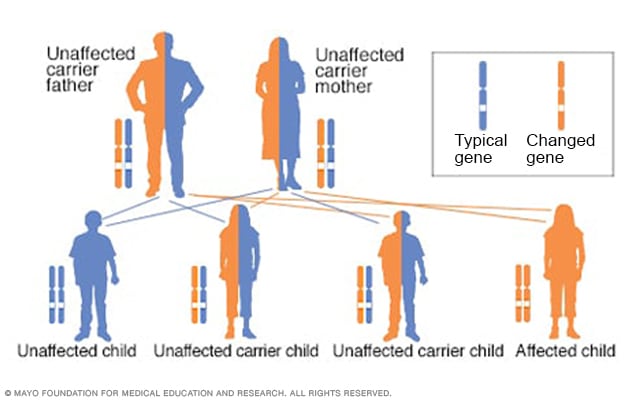Overview
Bardet-Biedl (BAR-day, BEE-dul) syndrome, also called BBS, is a rare condition caused by changes in genes. BBS can affect almost any part of the body. Starting in early childhood, extra weight gain and vision loss can happen. People with BBS also can have issues that include kidney conditions, changes in sex organ development, and extra fingers or toes. The condition can affect speaking, learning, thinking and memory.
There is no cure for Bardet-Biedl syndrome, but early diagnosis and treatment for conditions related to BBS can ease symptoms, lessen complications and help with a better quality of life. Because BBS can affect many body systems, different specialists may be needed to manage care.
Symptoms
Symptoms of Bardet-Biedl syndrome develop slowly. The symptoms usually are noticed during the first 10 years of life, but sometimes later. Symptoms and when they begin can vary greatly among people with BBS. Some people may have only a few mild symptoms. Others may have many or more severe symptoms.
Symptoms that occur more often may include:
- Having extra weight, starting in early childhood.
- Poor eyesight, leading to vision loss.
- Changes with how the kidneys develop and work.
- Low hormone levels that cause changes in sex organ development, delayed puberty and changes in sexual function.
- Extra fingers or toes, called polydactyly (pol-e-DAK-tuh-lee).
- Changes that affect speaking, learning, thinking and memory.
Other symptoms may include:
- Changes with the brain and nerves that may cause seizures or affect speech, walking, balance and coordination.
- Changes that affect mood and behavior.
- Medical conditions such as diabetes, high cholesterol, high blood pressure, sleep apnea and liver disease.
- Changes related to thyroid hormone.
- Digestive system conditions, such as inflammatory bowel disease or celiac disease.
- Not being able to smell, a condition called anosmia.
- Eye conditions, such as the eyes not focusing together, called strabismus, and clouding of the eye lens, called a cataract.
- Needing to urinate often during the day and night.
Developmental symptoms may include:
- Delays in growth and development.
- Short height and short fingers or toes. Sometimes two fingers or toes are attached by extra skin called webbing.
- Heart conditions present at birth.
- Dental conditions, including small, short teeth and a small lower jaw.
When to see a doctor
Because Bardet-Biedl syndrome is a rare condition, it can sometimes be hard to spot. Symptoms vary greatly and may start several years after birth. If you have concerns about your child's growth and development, health, behavior, or mental health, talk with your healthcare professional. You also can ask for a referral to a specialist in conditions that affect hormones in children, called a pediatric endocrinologist.
If your family has a history of BBS, talk with your healthcare professional about genetic testing.
Causes
Autosomal recessive inheritance pattern

Autosomal recessive inheritance pattern
To have an autosomal recessive disorder, you inherit two changed genes, sometimes called mutations. You get one from each parent. Their health is rarely affected because they have only one changed gene. Two carriers have a 25% chance of having an unaffected child with two unaffected genes. They have a 50% chance of having an unaffected child who also is a carrier. They have a 25% chance of having an affected child with two changed genes.
Changes in certain genes can cause Bardet-Biedl syndrome. These changes might be new or passed down from parents to children. Many different gene changes can result in BBS. Even though a lot has been learned about the genes linked with the condition, it's not fully understood how changed genes cause specific symptoms. Sometimes, healthcare professionals diagnose BBS based on symptoms because they can't find changes in genes.
BBS may be inherited in an autosomal recessive way. This means that each parent passes on one changed gene to the child.
Risk factors
Parents can pass down to their children the changes in genes that cause Bardet-Biedl syndrome.
Complications
Complications of Bardet-Biedl syndrome can include:
- Extra weight gain. Most people with BBS have extra body weight by the time they are 3 to 5 years old. This continues into adulthood. The extra body weight can affect health and limit the ability to do daily activities.
- Long-term kidney disease and loss of kidney function. Changes in how the kidneys develop and function can cause long-term kidney conditions. Extra body weight and diabetes raise the risk of developing kidney disease. Some people develop end-stage renal disease, which results in the kidneys not being able to filter waste and toxic substances from the body and get rid of them in urine.
- Vision loss and blindness. Rods and cones are the cells in the eye that are important for sight. These light-sensitive cells, called photoreceptors, are on the tissue at the back of the eye. This tissue is called the retina. With BBS, these rods and cones are slowly destroyed over time, a condition called retinal degeneration. Vision loss occurs in almost all people with BBS and often starts in early childhood. The first symptom may be trouble seeing in low light. Low vision, but not total blindness, usually happens around 15 years of age.
- Hormone imbalances. Changes in hormone balance can affect growth and development. Changes in development of the sex organs before birth, including the testicles and ovaries, can affect the hormones that cause puberty.
- Other health conditions. Having BBS can raise the risk of other medical conditions, such as diabetes, high blood pressure, high cholesterol, fatty liver disease, poor coordination and obstructive sleep apnea.
- Learning disabilities. Speaking, learning, thinking and memory can be affected and can impact daily functioning and independence.
- Behavioral issues and mental health conditions. Autism spectrum disorder is common. Other conditions can include depression, obsessive-compulsive disorder, anxiety, hyperactivity and behavior challenges.
Sept. 05, 2025